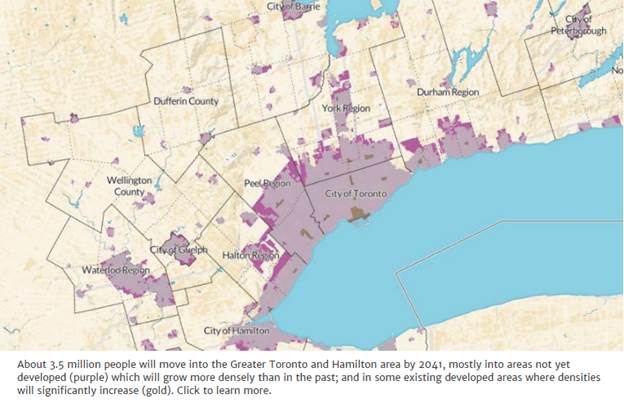
Ontario urged to ‘get ahead’ of coming population boom
Queen’s Park has refined its growth strategy, but critics wonder where the money is to back it up.
TheStar.com
June 5, 2016
San Grewal
Some 3.5 million people — more than Toronto’s current population — are expected to be added to the Greater Toronto and Hamilton Area over the next two decades.
Ontario is recognizing that this staggering pace of growth, first signalled in the Places to Grow plan of 2005, needs to be managed better. The province has announced new rules to help municipalities steer that growth. But critics are asking how the government will come up with the billions of dollars needed to provide relief from overcrowded schools and hospitals and poor GO Transit service in some of the highest-growth areas.
“With the growing population, things will get worse, not better, if we don’t get ahead of the curve,” said NDP Leader Andrea Horwath, who sat down with the Star recently in Brampton.
Horwath highlighted the widening funding gap for growth-related infrastructure, especially in communities whose population is already exploding — and which are expected to absorb the lion’s share of the population boom over the next 25 years.
“I’m not in government, I’m in opposition,” Horwath said. “So we get up and we try to flag these concerns and issues for the government. But we don’t see a real, co-ordinated approach. In fact, what we see is more of a reactionary approach, almost like they’re putting out fires when they can.
“But their overall vision is not about the future — I’m sorry, but I’m going to be honest with you — it’s about dollars and deficits, not about the well-being of people, not about meeting the population pressures.”
A new report by public affairs consulting firm StrategyCorp, highlighting the biggest concerns of 25 municipal chief administrative officers across Ontario, is similarly blunt.
“Provincial assumptions about growth are not keeping up to date with ‘on the ground experience,’” the report says, quoting another CAO as saying: “There is no provincial strategy for economic development — especially not for (the) GTA.”
Three weeks ago, the Liberal government rolled out its plans to bolster existing growth legislation. The new plans place the onus squarely on municipalities to encourage higher population densities while curtailing urban sprawl, to make more efficient use of land and infrastructure funding.
At the announcement, the Star asked Finance Minister Charles Sousa how his government plans to pay for the growth it has mandated to municipalities such as Milton, where the population is booming, while better co-ordinating growth-related services among government ministries.
“We made a commitment to invest — historic investments, I may add — $160 billion over the next 12 years, which will affect all communities ... to enable the influx of families that are moving into these areas,” Sousa said. He added that growth issues have been “neglected for far too long in previous regimes.”
“That’s why this plan and this co-ordinated review is being taken, so that we make appropriate assessments,” he said.
Sousa said the province is also working with Ottawa to help manage and fund future growth in the region.

One of the biggest issues officials in Milton and other high-growth municipalities have raised is poor funding for transit and transportation.
Transportation Minister Steven Del Duca called it “crucial” that investments are focused on where growth is taking place, and that the province needs to do a “better” job of this.
“We have to work together to make sure that we are aligning the growth with where those transit investments are occurring,” he said.
Milton Councillor Colin Best has been a vocal critic of the province’s failure to support the growth it mandated.
“The lack of any long-term budgeting for growth by the province is a huge problem,” Best said. “The Ministry of Education, for example, does not align the number of schools it will budget to be built with the growth targets the province has given us. It gives us no idea. Right now we need eight new elementary schools and two new high schools, but we have no clue if we’re going to get them.”
Milton’s population has spiked from 7,018 in 1971 to about 120,000, and Best said it is set to double again in less than 20 years.
Milton has kept in line with the province’s growth legislation, which came into effect in 2006, and is already achieving population densities above the 80 people per hectare the province recommended.
“But where’s the money and the co-ordination from the province?” Best asked.
Schools in Milton are already overcrowded, with some using more than 20 portables, he said.
“The province has just increased Halton’s population target by an additional 40,000,” Best said. “The region’s population will now pretty much double by 2041, to over a million residents. We just can’t handle this growth if the province doesn’t figure out how it’s going to manage it and pay for it.”
Horwath agreed. Moments after visiting Brampton Civic Hospital, she singled out the issue of health-care capacity.
“If the government can’t even provide the services, so that people can’t even get the kind of health care they need, when they need it and where they need it, then the government is failing on one of the most basic priorities that people have.”
She pointed to data that shows hospital capacities in high-growth communities are well beyond what her party calls “internationally recognized safe occupancy rates.”
“In terms of actual fundamental planning for the future, we don’t see that, in a co-ordinated, cross-ministerial way. We don’t see that.”
